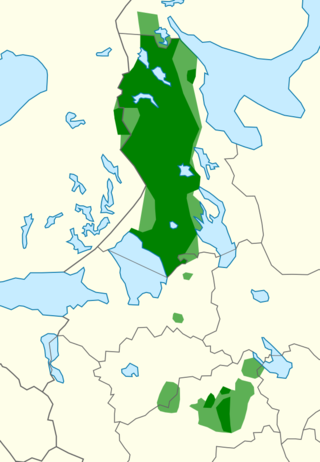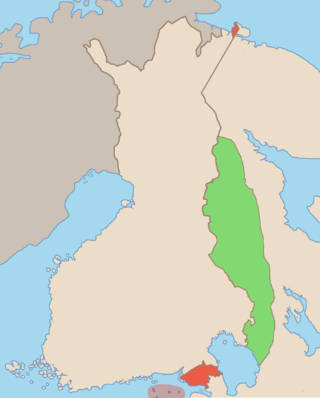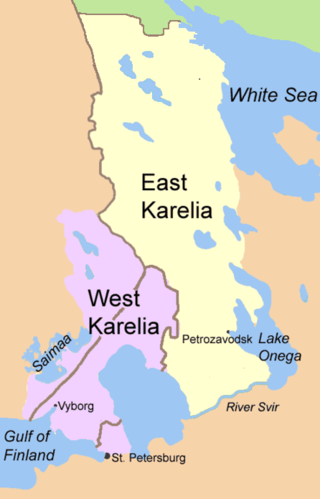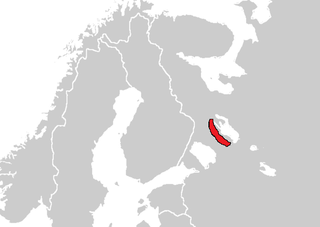
The Republic of Karelia, Karjala or Karelia, is one of the republics of the Russian Federation situated in the northwest of the country. The republic is a part of the Northwestern Federal District, and covers an area of 172,400 square kilometres, with a population of 533,121 residents. Its capital is Petrozavodsk.

Karelian is a Finnic language spoken mainly in the Russian Republic of Karelia. Linguistically, Karelian is closely related to the Finnish dialects spoken in eastern Finland, and some Finnish linguists have even classified Karelian as a dialect of Finnish, though in the modern day it is widely considered a separate language. Karelian is not to be confused with the Southeastern dialects of Finnish, sometimes referred to as karjalaismurteet in Finland. In the Russian 2020–2021 census, around 9,000 people spoke Karelian natively, but around 14,000 said to be able to speak the language.
The Aunus expedition was an attempt by Finnish volunteers to occupy parts of East Karelia in 1919, during the Russian Civil War. Aunus is the Finnish name for Olonets Karelia. This expedition was one of many Finnic "kinship wars" (heimosodat) fought against forces of Soviet Russia after the Russian Revolution of 1917 and during the Russian Civil War.

Karelians are a Finnic ethnic group who are indigenous to the historical region of Karelia, which is today split between Finland and Russia. Karelians living in Russian Karelia are considered a distinct ethnic group closely related to Finnish Karelians, who are considered a subset of Finns. This distinction historically arose from Karelia having been fought over and eventually split between Sweden and Novgorod, resulting in Karelians being under different cultural spheres.

Karelia is a historical province of Finland, consisting of the modern-day regions of South Karelia and North Karelia. Historical Karelia also extends to the regions of Kymenlaakso, Northern Savonia and Southern Savonia (Mäntyharju).

The Finnish Democratic Republic, also known as the Terijoki Government, was a short-lived communist puppet state of the Soviet Union in occupied Finnish territory from December 1939 to March 1940.

East Karelia, also rendered as Eastern Karelia or Russian Karelia, is a name for the part of Karelia that since the Treaty of Stolbovo in 1617 has remained Eastern Orthodox and a part of Russia. It is separate from the western part of Karelia, called Finnish Karelia or historically Swedish Karelia. Most of East Karelia has become part of the Republic of Karelia within the Russian Federation. It consists mainly of the old historical regions of Viena Karjala and Aunus Karjala.

Karelia is an area in Northern Europe of historical significance for Russia, Finland, and Sweden. It is currently divided between northwestern Russia and Finland.

Ludic, or Ludian, or Ludic Karelian, is a Finnic language in the Uralic language family or a Karelian dialect. It is transitional between the Olonets Karelian language and the Veps language. It is spoken by 300 Karelians in the Republic of Karelia in Russia, near the southwestern shore of Lake Onega, including a few children.

Greater Finland, was an irredentist and nationalist idea which emphasized the territorial expansion of Finland. The most common concept of Greater Finland saw the country as defined by natural borders encompassing the territories inhabited by Finns and Karelians, ranging from the White Sea to Lake Onega and along the Svir River and Neva River—or, more modestly, the Sestra River—to the Gulf of Finland. Some proponents also included the Torne Valley, Ingria, and Estonia.
ProKarelia is a Finnish fringe irredentist group that works for the return to Finland of Finnish Karelia, Petsamo, Salla and some islands in Gulf of Finland ceded to the Soviet Union in past treaties in Moscow and Paris. As a preliminary goal the group hopes to overturn the articles of the Paris Peace Treaty of 1947 and remove Finnish responsibility in starting the Continuation War.

Karelia has appeared in philately several times; first as a breakaway republic from Soviet Russia in 1922, later when Eastern Karelia was occupied by Finland during the Continuation War of 1941 to 1944, and in the post-Soviet period when provisional stamps and cinderellas were issued. Additionally, there were Zemstvo stamps used in the early 20th century on the territory of the contemporary Republic of Karelia.

Ladoga Karelia is a historical region of Karelia, currently largely in Russia. Today, the term refers to the part of the Republic of Karelia in the Russian Federation comprising the south-west part of the Republic, specifically Lakhdenpokhsky District, Pitkyarantsky District and Sortavala District. This region is on the northern littoral of Lake Ladoga, which borders Olonets Karelia to the East, Leningrad Oblast to the south-west and the North Karelia region of Finland to the west.

The East Karelian Uprising and the Soviet–Finnish conflict 1921–1922 were an attempt by a group of East Karelian separatists to gain independence from the Russian Soviet Federative Socialist Republic. They were aided by a number of Finnish volunteers, starting from 6 November 1921. The conflict ended on 21 March 1922 with the Agreements between the governments of Soviet Russia and Finland about the measures of maintenance of the inviolability of the Soviet–Finnish border. The conflict is regarded in Finland as one of the heimosodat – "Kinship Wars".

The Finnish military administration in Eastern Karelia was an interim administrative system established in those areas of the Karelo-Finnish Soviet Socialist Republic (KFSSR) of the Soviet Union which were occupied by the Finnish army during the Continuation War. The military administration was set up on 15 July 1941 and it ended during the summer of 1944. The goal of the administration was to prepare the region for eventual annexation by Finland.
Čičiliusku is a puppet theatre company from the Republic of Karelia in Russia. The company performs in the Karelian language. The company was founded in 2005 at the initiative of Pekka Zaikov, who at the time was the head of the Department of the Karelian and Veps languages. Amongst those who founded the company were teachers, students and alumni of the Faculty of Baltic Finnic languages of the Petrozavodsk State University. The Karelian folk theater was created in order to preserve the Karelian national intangible culture, popularize the Karelian language among children and youth language, introducing the younger generation to ethnocultural activities. A year later the company performed their first play, Kuin hukka vasikalla muamona oli.

The Republic of Uhtua, officially called the Republic of East Karelia was an unrecognized state that existed from 1919 to 1920, formed out of five volosts in the Kemsky Uyezd of the Arkhangelsk Governorate.
Lyudmila Fyodorovna Markianova is a Karelian linguist and a professor emerita. She has been called "karjalan kielen muamo", i.e. 'mother of the Karelian language'.

Yrjö Oskar Ruutu was a Finnish social scientist and politician. Ruutu was the first principal of the School of Social Sciences 1925–1932, 1935–1945 and 1949–1953, and the first Finnish professor of International relations 1949–1954. Ruutu was the first in Finland to defend his doctoral thesis on social sciences and wrote the first Finnish presentation on international relations as a science. He was also the head of the National Board of Education 1945–1950.
For Independence was a right-wing political organization operating in Finland in the 1970s and 1980s, which opposed the influence of the Soviet Union in Finland, the policy of President Urho Kekkonen and socialism.

















